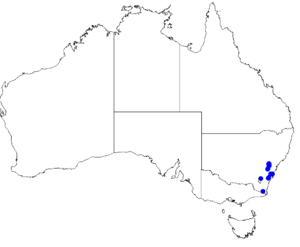Deane's boronia facts for kids
Quick facts for kids Deane's boronia |
|
|---|---|
 |
|
| Boronia deanei leaves and flowers | |
| Conservation status | |
| Scientific classification | |
 |
|
| Occurrence data from Australasian Virtual Herbarium |
The Boronia deanei, also known as Deane's boronia, is a special plant. It belongs to the citrus family called Rutaceae. This plant is only found in the central and southern highlands of New South Wales, Australia. It's a shrub that stands upright and has leaves that smell very strong. Its flowers can be white or bright pink and bloom in late winter and spring.
Contents
What it Looks Like
Deane's boronia is a shrub that grows straight up. It can reach a height of about 0.2 to 1.5 metres (0.7 to 4.9 feet). Its branches are slightly angled and have small bumps. The leaves are divided into narrow, paired parts. These parts are thick, very fragrant, and shaped like lines. They are about 4 to 12 millimetres (0.16 to 0.47 inches) long and 0.5 to 2 millimetres (0.02 to 0.08 inches) wide. The top of the leaves is smooth, but the bottom has small, bumpy glands.
The flowers grow near the ends of the branches in groups of up to three. Each flower has a short stalk, about 1 to 3 millimetres (0.04 to 0.12 inches) long. The petals are white to bright pink and are about 4 to 5 millimetres (0.16 to 0.20 inches) long. Their edges overlap each other. Each flower has eight stamens (the parts that produce pollen). Deane's boronia flowers between August and November. Its fruit appears in December.
How it Got its Name
Boronia deanei was first officially described in 1907. Two scientists, Joseph Maiden and Ernst Betche, gave it its name. They studied a plant sample collected by Henry Deane in the Blue Mountains. The name deanei was chosen to honor Henry Deane, who found the first sample of this plant.
In 2002, another scientist named Marco Duretto found that there are two slightly different types, or subspecies, of Deane's boronia. These are:
- Boronia deanei subsp. deanei: This type has leaflets with a rounded or blunt tip.
- Boronia deanei subsp. acutifolia: This type has leaflets with a pointed tip.
Where it Lives
This boronia mostly grows in the higher parts of the Blue Mountains. You can find it north of Clarence, in the Kanangra-Boyd National Park, and south to the South East Forests National Park. It likes to grow near swamps at high altitudes. It also lives in wet heathlands and open forests, often in soil that doesn't drain water very well.
Why it Needs Protection
Deane's boronia is listed as "Vulnerable." This means it's at risk of disappearing if we don't protect it. Both the Australian government and the New South Wales government have laws to protect it. The main dangers to this plant are damage to its home from wild pigs (Sus scrofa) and land being cleared for new homes and buildings.
Growing it in Gardens
Deane's boronia is a good plant for gardens. It can grow well even in soil that doesn't drain water perfectly. It can also handle frost quite well. People like to grow it because its leaves smell nice and its pink flowers are pretty. Some plants grown in pots at the Australian National Botanic Gardens have reached a height of 2 metres (6.6 feet). They only need a little trimming, occasional plant food, and enough water in the summer.


